UY Scuti is a red supergiant or red hypergiant star located in the direction of the constellation Scutum. With a radius of 909 solar radii, it is one of the largest stars known. The pulsating variable star varies in brightness from magnitude 8.29 to 10.56 and is invisible to the unaided eye. It lies approximately 5,871 light-years away.
UY Scuti is a previous record holder for the largest star known. The supergiant star was believed to lie at a much greater distance – 9,500 light-years away – and had an estimated radius of 1,708 solar radii. More recent studies place it much closer and give it a smaller size.
With an absolute magnitude of -6.2, UY Scuti is an exceptionally luminous star – about 124,000 times more luminous than the Sun – but its location and distance make it dimmer when seen from Earth. UY Scuti lies in the region of the sky known as the Zone of Avoidance and is heavily obscured by the Milky Way.
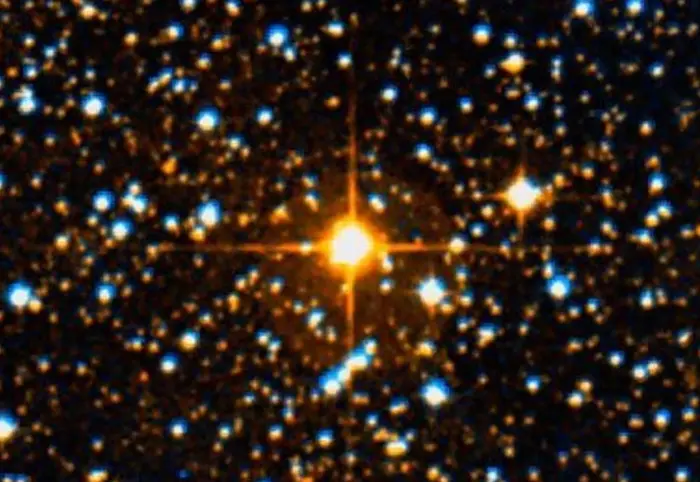
UY Scuti, image: Wikisky (DSS)
Star type
UY Scuti is an evolutionary red hypergiant with the stellar classification M2-M4Ia-Iab. With a surface temperature of 3,550 K, the star is about 124,000 times more luminous than the Sun. Previous estimates of its luminosity were in the range between 180,000 and 630,000 times that of the Sun.
The estimated mass of UY Scuti is between 7 and 10 times the mass of the Sun. The star’s mass cannot be calculated directly because UY Scuti does not have any companions and is not a member of a star cluster. Astronomers believe it has a mass of 7 – 10 solar masses based on theoretical grounds. The star is believed to have started its main sequence life with a mass between 20 and 40 solar masses but has shed most of its initial mass through a strong stellar wind.
The star is losing mass at a rate of 5.8 x 10-5 solar masses per year. As a result, it is surrounded by a large and complex envelope of dust. The cloud of gas lost by the star is 400 astronomical units across.
UY Scuti is enshrouded in dust and does not have any visible companions, which makes it difficult to determine its stellar parameters with a high degree of certainty. The presence of companions would allow scientists to measure the star’s mass through gravitational interference.
UY Scuti is classified as a semiregular variable star of the subtype SRc. These stars are typically variable supergiants of late spectral classes. Their brightness changes because the stars change in size as they pulsate. UY Scuti has a pulsation period of about 740 days.
Several well-known behemoths belong to this group, including Betelgeuse (640 R☉), Rasalgethi (284 R☉), MY Cephei (1,134 – 2,061 R☉), Mu Cephei (972 R☉), VV Cephei (779.27 R☉), EV Carinae (1,168 R☉), VX Sagittarii (1,356 R☉), KW Sagittarii (1,009 R☉), AH Scorpii (1,411 R☉), PZ Cassiopeiae (1,364 R☉), NML Cygni (1,640 R☉), RW Cygni (1,000 R☉), and possibly VY Canis Majoris (1,420 R☉).
Size
UY Scuti has a radius about 909 times that of the Sun. The value was derived in 2023 based on distance measurements (5,871 ly) obtained in Gaia Data Release 3 (Gaia DR3) and near-infrared photometry from the Two Micron All Star Survey (2MASS). The estimated distance, including the margin of error, is between 5,425 and 6,405 light-years.
Previous measurements of the star’s parallax by the Gaia space observatory (Gaia DR2) yielded significantly lower values for the star’s distance (5,100 light years) and consequently luminosity (86,300–87,100 L☉) and radius (755 R☉). However, the Gaia measurements may have been affected by astrometric noise and were not completely reliable.
UY Scuti was previously considered the largest star known, with an estimated radius about 1,708 times that of the Sun. This corresponded to a size of 1.188 x 109 kilometers or 7.94 astronomical units (Earth-Sun distances).
The size of a red supergiant or hypergiant is notoriously difficult to determine. These stars pulsate and have diffuse edges, without a harsh dividing line between the star and the interstellar medium. Astronomers use the star’s photosphere to measure its size. The photosphere is the deepest region of a star, where the star becomes transparent to light. It extends into the surface to an optical depth of about 2/3, which is a depth from which 50% of the star’s light can escape without scattering.
As UY Scuti belongs to the class of variable stars that vary in brightness because they vary in size, the star’s radius will probably change over time.
Size comparison
With a radius of 909 solar radii, UY Scuti is still a behemoth compared to many other red supergiants and giants, including Betelgeuse (640 R☉), Antares (680 R☉), V838 Monocerotis (467 R☉), La Superba (422 R☉), Mira (541 R☉), and Rasalgethi (284 R☉).
However, it is no longer in the company of the record-breaking Stephenson 2-18 (2,150 R☉), WOH G64 (1540 R☉), and RSGC1-F02 (1,500 R☉). It is also smaller than VY Canis Majoris (1,420 R☉), AH Scorpii (1,411 R☉), VX Sagittarii (1,356 R☉), and NML Cygni (1,183 – 2,770 R☉). The largest of these stars exceed the current theoretical limit on star size (1,500 R☉).
UY Scuti compared to the Sun
With a radius 909 times that of the Sun, UY Scuti is one of the largest stars known in the Milky Way. If the supergiant were placed at the centre of the solar system, its photosphere would swallow the planets Mercury, Venus and Earth, and extend more than halfway between Mars and Jupiter.
Previous estimates of the supergiant’s radius (1,708 R☉) suggested a size of almost eight astronomical units (750 million miles), corresponding to a volume almost 5 billion times that of the Sun. With a radius 1,708 times that of the Sun, the red supergiant would engulf the orbit of Jupiter (1,114.5–1,115.8 R☉) and its photosphere would extend closer to the orbit of Saturn (2,047–2,049.9 R☉).
To illustrate, if the Earth were the size of a ball 20 cm (8 inches) in diameter, Jupiter would be 2.1 m (7 feet) in diameter, the Sun would be 22 m (7 feet) across, and the diameter of UY Scuti would extend for about 38,000 m (125,000 feet). A hypothetical object moving at the speed of light would take only 14.5 seconds to travel around the Sun, while it would need about seven hours to circle around UY Scuti.
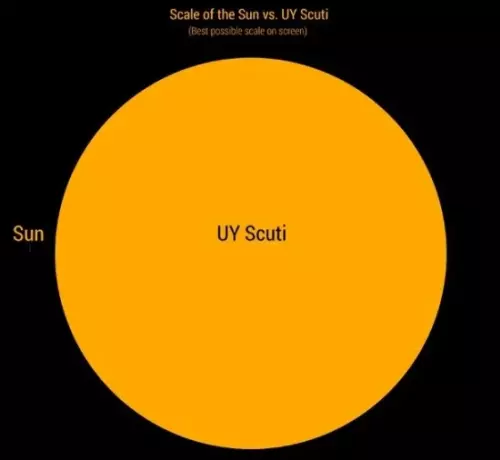
UY Scuti compared to the Sun, image: Wikimedia Commons/Philip Park (CC BY-SA 3.0)
UY Scuti compared to Stephenson 2-18
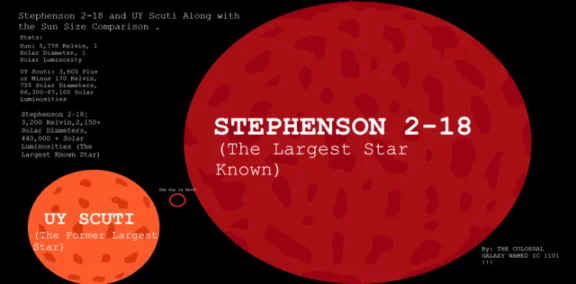
A size comparison of the Sun, UY Scuti and Stephenson 2-18, image: Wikimedia Commons/THE COLOSSAL GALAXY NAMED IC1101 (CC BY-SA 4.0)
Mass
With an estimated mass between 7 and 10 times the mass of our Sun, UY Scuti is massive enough to end its life as a fiery supernova. However, it does not make the list of the most massive stars known.
A star’s size does not always correlate with its mass. Despite its enormous size, the red supergiant star is less massive than some smaller red supergiants, including Antares (11 – 16 M☉) and Betelgeuse (14 – 19 M☉). It does not even come close to the most massive stars known, BAT99-98 (226 M☉), R136a1 (196 M☉), and Melnick 42 (189 M☉). These record-holding stars lie in the Tarantula Nebula (30 Doradus) in the Large Magellanic Cloud (LMC) and have modest radii of 37.5 (BAT99-98), 42.7 (R136a1), and 21.1 (Melnick 42) solar radii.
In terms of mass, UY Scuti also does not come close to the famous Eta Carinae A (100 M☉), the central star of the Carina Nebula, or to the Peony Star (WR 102ka, 100 M☉), which illuminates the Peony Nebula.
Supernova
UY Scuti is massive enough to be a supernova candidate. Based on its known properties, the star is fusing hydrogen around its core and has begun to fuse helium. It is expected to evolve back to hotter temperatures and eventually become either a yellow hypergiant, a Wolf-Rayet star, or a luminous blue variable.
The star’s location in the galactic disc indicates that it is metal-rich. Once it runs out of helium, it will keep fusing progressively heavier elements until it develops an iron core. This will disturb the balance needed to sustain the core against its own gravity, triggering a core collapse. As a result, the star will end its life in a supernova event, leaving behind a neutron star or a black hole.
When it does, the X-ray and gamma-ray radiation will not affect Earth. For a supernova blast to damage our ozone layer, it would need to occur within 50 light years and UY Scuti lies 5,871 light years away. However, the supernova will likely be visible from Earth even without a telescope.
Facts
UY Scuti was given the designation BD-12°5055 by a group of German astronomers at the Bonn Observatory, who were the first to catalogue the star in 1860. They discovered the supergiant while conducting a survey for the Bonner Durchmusterung (BD) astrometric star catalogue.
Another survey showed a slight change in the star’s brightness, and the star was subsequently given the variable star designation UY Scuti, as the 38th variable star found in Scutum.
The previously accepted record-breaking size of 1,708 solar radii was calculated after a survey with the Very Large Telescope (VLT) in Chile’s Atacama Desert, conducted in 2012 to measure the parameters of three large stars in the region of the sky near the Galactic Centre. The observations were carried out in the near-infrared K band with the VLTI/AMBER instrument. The other two stars included in the study were AH Scorpii and KW Sagittarii, also red supergiants with a luminosity over 100,000 times that of the Sun and among the largest stars known.
The researchers estimated the Rosseland-mean photospheric angular diameter (where the Rosseland optical depth equals 2/3) of UY Scuti to be 5.48 ± 0.10 milliarcseconds. Combined with the distance of 9,500 ly, they found a radius of 1,708 solar radii and derived an initial mass of 25 solar masses for a rotating star and up to 40 solar masses for a non-rotating one.
Following the discovery of the supergiant’s size, UY Scuti was named the largest known star, leaving behind VY Canis Majoris, NML Cygni, and Betelgeuse, which had all previously carried the title.
Location
UY Scuti lies two degrees north of the white magnitude 4.67 star Gamma Scuti, in the region of the sky just northeast of the famous Eagle Nebula (Messier 16). The star can be observed in a 4-inch or larger telescope in good conditions. The open cluster NGC 6604 (mag. 6.5) is located in the same area of the sky.
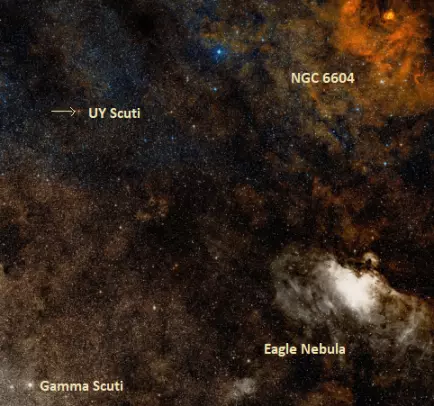
UY Scuti location, image: Wikisky
Constellation
UY Scuti is located in the constellation Scutum, the Shield. The constellation was created by the Polish astronomer Johannes Hevelius in 1684. It was originally named Scutum Sobiescianum in honour of the Polish King John III Sobieski and his triumph in the 1683 Battle of Vienna.
Scutum is one of the smallest constellations in the sky (84th in size out of 88). It stretches across an area of only 109 square degrees of the southern sky.
None of the stars in Scutum are among the 300 brightest stars in the sky. The four brightest stars in the constellation form an elongated diamond-shaped asterism that is visible near the tail of Aquila (the Eagle) on a clear night. Alpha Scuti, the brightest star in Scutum, is an orange giant with an apparent magnitude of 3.83. Other Scutum stars are fainter than magnitude 4.0.
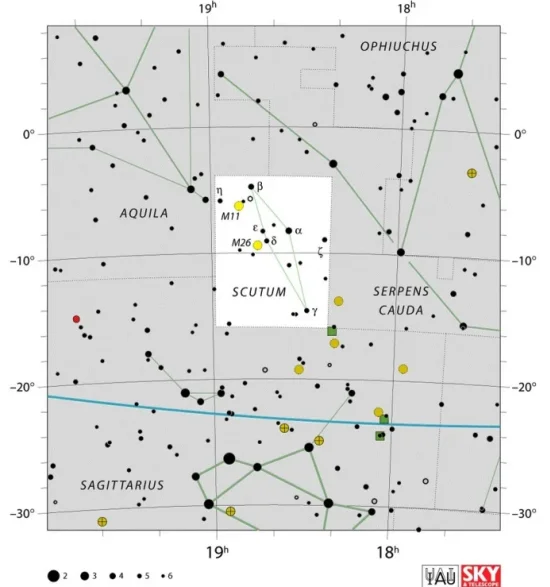
Scutum constellation map by IAU and Sky&Telescope magazine
Scutum is home to the famous variable star Delta Scuti, an F-type giant that serves as a prototype for its own class of variable stars. Delta Scuti variables are young stars that exhibit variations in brightness due to pulsations.
Scutum also contains Stephenson 2-18, a red hypergiant star that currently holds the record for the largest star known, with a radius 2,150 times that of the Sun.
Scutum hosts several relatively bright deep sky objects that are popular targets for stargazers. These include the famous Wild Duck Cluster (Messier 11), an exceptionally rich and densely populated open cluster with an apparent magnitude of 5.8, the fainter open star cluster Messier 26 (mag. 8), the globular cluster NGC 6712 (mag 8.69), and the planetary nebula IC 1295 (mag. 12.7).
Scutum is also home to the young open clusters RSGC1 (Red Supergiant Cluster 1) and RSGC3, both among the most massive clusters known in the Milky Way galaxy.
The best time of the year to observe the stars and deep sky objects in Scutum is during the month of August, when the constellation rises high above the horizon in the early evening. The entire constellation is visible from locations between the latitudes 80° N and 90° S.
The 10 brightest stars in Scutum are Alpha Scuti (mag. 3.83), Beta Scuti (mag. 4.22), Zeta Scuti (mag. 4.66), Gamma Scuti (mag. 4.67), Delta Scuti (mag. 4.60 – 4.79), Eta Scuti (mag. 4.83), Epsilon Scuti (mag. 4.88), HD 175156 (mag. 5.08), HD 171391 (mag. 5.12), and R Scuti (mag. 4.2 – 8.6).
UY Scuti
| Spectral class | M2-M4Ia-Iab |
| Variable type | Semiregular variable (SRc) |
| U-B colour index | +3.29 |
| B-V colour index | +3.00 |
| Apparent magnitude | 8.29 – 10.56 |
| Absolute magnitude | −6.2 |
| Distance | 5,871 light-years (1,800 parsecs); 5,425 – 6,405 light-years (1,663 – 1,964 parsecs) |
| Parallax | 0.5166 ± 0.0494 mas |
| Radial velocity | 18.33 ± 0.82 km/s |
| Proper motion | RA: -0.288 ± 0.053 mas/yr |
| Dec.: -2.718 ± 0.044 mas/yr | |
| Mass | 7 – 10 M☉ |
| Luminosity | 124,000 L☉ |
| Radius | 909 R☉ |
| Temperature | 3,550 K |
| Surface gravity | -2.5 cgs |
| Constellation | Scutum |
| Right ascension | 18h 27m 36.5281722864s |
| Declination | −12° 27′ 58.898573712″ |
| Names and designations | UY Scuti, UY Sct, BD-2 5055, HV 3805, PPM 234561, RAFGL 21162, GSC 05698-05176, IRAS 18248-1229, TYC 5698-5176-1, Gaia DR2 4152993273702130432, Gaia DR3 4152993273702130432, IRC-10422, WISE J182736.57-122800.7, 2MASS J18273652-1227589 |